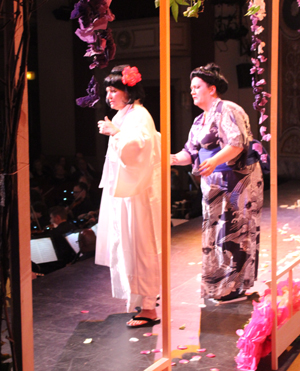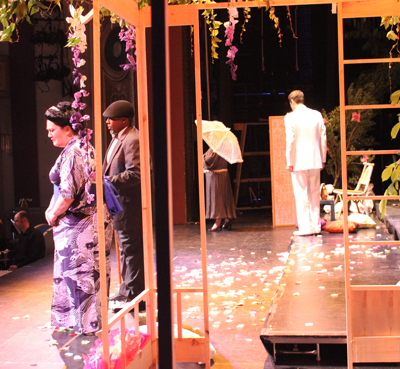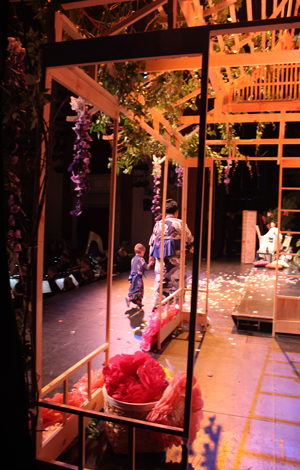by J.D. Goddard

Although the Ohio Theater was not conceived with opera productions in mind, it is all the more to the credit of executive director, Dorata Sobieska that Puccini’s tearjerker worked relatively well on a stage with limited space and in a venue where voices don’t project well into the house.
Madama Butterfly premiered in 1904. The story, based on not so far-fetched accounts, takes place at that time in Nagasaki, blending the exoticism and customs of Japan with a tragedy precipitated by the actions of an outsider. Through Goro, a marriage broker, the 15-year-old geisha Cio-Cio San (Butterfly in English) marries US Naval Lieutenant Pinkerton in a marriage of convenience. But Butterfly has fallen in love with Pinkerton, converted to Christianity and is subsequently renounced by her relatives. Though shamelessly attracted to Butterfly’s youth, Pinkerton’s actions are reckless. Toying with Japanese law and fully intending to find a “real” US bride, he departs, insensitively leaving Butterfly believing that he’ll return — and not knowing she will bear his child.
As Cio-Cio San, Dorota Sobieska captured attention with the light lyric beauty of her tone when her voice was first heard, rising out of the female chorus. She maintained that quality, even when her character came under the emotional pressure dictated by the drama.
Tenor Isaac Hurtado brought a nicely-placed, full-bodied voice to the the dashing yet conniving character of Pinkerton. His exceptional attention to detail produced a characterization filled with passion and intensity. His voice carried well into the house, and physically, he fit the part perfectly.
Mezzo-soprano Christina Carr sang the role of Suzuki, Butterfly’s servant, beautifully and with convincing restraint. She showed a sympathetic understanding of the consequences surrounding Butterfly’s ill-fraught marriage, impending tribulations and ultimate demise.
As Sharpless, the US consul, James Binion’s smooth, burnished baritone was perfectly matched to his role as a diplomat, a part he played with confident ease.
The evening’s most impressive voice belonged to Brian Skoog, who poignantly portrayed Goro, Butterfly’s marriage broker, with resonant, ringing brilliance. He made a lasting impression.
Satisfying performances came from singers in the smaller roles, notably Shaun McGrath as Prince Yamadori, William Roberts as Bonzo, Christopher Aldrich as Yakuside, Jeremy Gilpatric as El commissario imperiale, Joel Rhoads as L’ufficiale del registro, Laura Avdey as La madre, Nicole Wong as La zia, Rachel Morrison as La cugina, and Grey Buo as Il bambino. The chorus overcame some early murkiness to glow with beauty in the “Humming Chorus” at the end of Act II.
Conductor Grzegorz Nowak paid close attention to the interpretive needs of the singers while wielding an authoritative stick. His romantic bending of phrases was mirrored by the orchestra, who played at a high level and added wonderfully to the opera’s dramatic moments.
The production’s frugal sets, including an upstage scrim, restrained lighting and minimal staging, might have been more effectively utilized to underline the opera’s tragic content.
At the conclusion, Butterfly’s death was depicted by washing the stage in red light and projecting a graphic of dripping blood on the upstage scrim. It was interesting, but anti-climactic. Perhaps Butterfly could have appeared behind the scrim as a shadow figure plunging the dagger into her abdomen, an effect more consistent with the fatal ending of the opera.
Photos by Victoria Lang
Published on ClevelandClassical.com June 16, 2015.
Click here for a printable copy of this article







